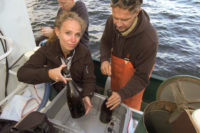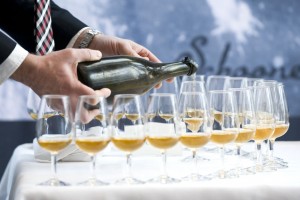 In 2010, a shipwreck laden with intact bottles of centuries-old champagne and beer was discovered in the waters off Aaland, an autonomous island province in the southwest of Finland’s archipelago. The exact date the twin-masted schooner sank to a watery grave could not be determined, but the type of ship indicated it was made in the first quarter of the 19th century, closer to 1830 than 1800.
In 2010, a shipwreck laden with intact bottles of centuries-old champagne and beer was discovered in the waters off Aaland, an autonomous island province in the southwest of Finland’s archipelago. The exact date the twin-masted schooner sank to a watery grave could not be determined, but the type of ship indicated it was made in the first quarter of the 19th century, closer to 1830 than 1800.
The cold, dark Baltic had preserved the beverages well — one of the beer bottles leaked its contents and it was still foaming — and there was much excitement in Aaland at the possibility that the oldest drinkable champagne had been found off their coast, so much excitement that the drinking started before the oldest title was conclusively established. Two bottles of shipwreck champagne were opened and served to the press a few months after they were recovered. There was no fizz left and it was crazy sweet (a bottle of champers in the late 18th century had 100 grams of sugar vs. nine grams today), but it was technically drinkable.
As the dating of the ship inched closer to the previous record-holder (a bottle of 1825 Perrier-Jouet), the odds of this being the oldest champagne had to be shaved down from gung ho to razor thin. It was still old and rescued from a shipwreck, though, and Aaland was planning on auctioning off most of the bottles, blending some with modern vintages to make it less gross to the modern palate.
Well, those plans will have to be revised because French vinter Veuve-Clicquot, the revered label that bottled three or four of the 168 bottles recovered from the wreck, has analyzed the champagne and judged it undrinkable.
Åland’s culture minister Tony Asumaa visited France last week, to hear about the champagne firm’s analysis. A sample bottle of the shipwreck bubbly was sent to Veuve Clicot last year.
At the time, the champagne treasure discovery made headlines around the world. It also caused local controversy when Finland’s deputy chancellor of justice reprimanded the Åland regional government for recovering the shipwreck cargo before receiving permission from the National Board of Antiquities. In 2011 and 2012 Åland’s government had sold off some of the bottles for record prices at auction and pocketed the considerable proceeds.
“Sure, it was champagne, but not of the quality that we wanted, so it is not worth it. From now own we will classify [the bottles of champagne] as museum pieces, not something to consume,” Asumaa told Aland Radio.
Maybe something that should have been established before the toasting began eight years ago, but okey dokey.

Ah, so it was like the rich man’s energy drink of the past.